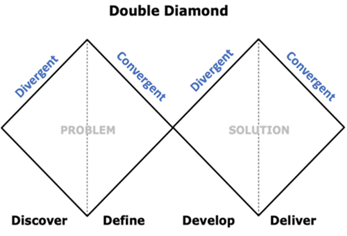Design thinking is a powerful approach to innovation that places the user or customer at the center of the innovation process. It takes its name from the fact that it uses the tools and methods of a designer to develop products and services that better meet people´s needs.
Good designers never start by solving the problem that is given to them: they start by trying to understand what the real issues are for the users of a product or service. Hence a distinctive characteristic of Design Thinking is that substantial amounts of time are devoted up-front in a project to exploring the problem to be solved and ensuring that this is the “right” problem. Designers are trained to discover the real problems that the users face.
The Design Thinking process can be depicted in many ways, however, the simplest and most common of these is called the Double Diamond model. This model was developed by the British Design Council, this model captures the two main phases in a design thinking project.
These two main phases are: diverge and converge. In the divergent phases, designers explore a wide range of ideas, perspectives, and potential solutions. The converge phases are used to narrow down the scope of the project and refine potential solutions. The double diamond model can be used to help guide the design process from problem definition to prototype testing.

- Discover – In this stage, the team gathers as much information as possible about target customers, the problems they faced, and the unmet needs they have. Two methods are particularly useful in this respect. First, customer interviews allow teams to understand what aspects of a product or service customers are unhappy with, and how these products fit into their daily lives. Second, customer observation basically consists in watching how users interact with a product or service.
- Define – This involves gathering data from the empathize stage and synthesizing it to come up with a concise problem statement. It is important to distill the research down to a single focused statement and understand the core problem the user is experiencing from a holistic viewpoint. This allows you to develop a comprehensive and consistent understanding of the issue and create meaningful solutions.
- Develop – This is the stage where teams come up with alternative solutions to the customer problems defined earlier. The goal is to avoid locking in the choice of a solution too early, before considering alternatives. The main tool used in this stage is brainstorming – it consists of a structured approach to generating many creative and divergent solutions.
- Deliver – Teams now develop prototypes of proposed solutions and test them with customers, to discover which aspects of an idea work well, and how they might be improved. A prototype representation of an idea that allows a team to gain insight into its value. These can range from simple sketches or physical mockups with “low fidelity”, to working versions that test specific aspects of performance. While the double diamond model is depicted as a linear process, this is not the case in practice. It is inherently iterative, within each phase and throughout the entire process. Iteration happens in the problem phase, as teams learn more about the target customer and the potential problems that are most valuable to solve. Iteration happens into improved versions of the product. Given this dynamic, in a typical project, teams will engage in multiple cycles of the problem-solution discovery process.